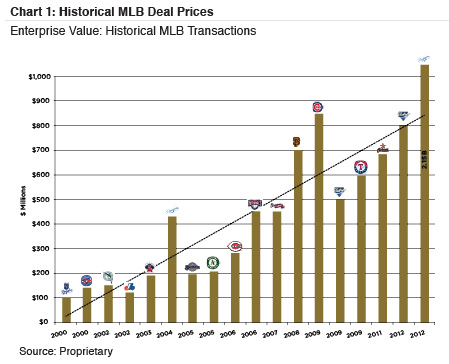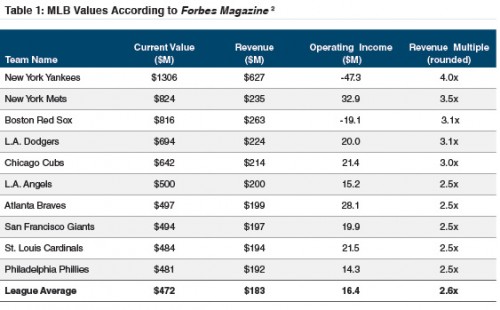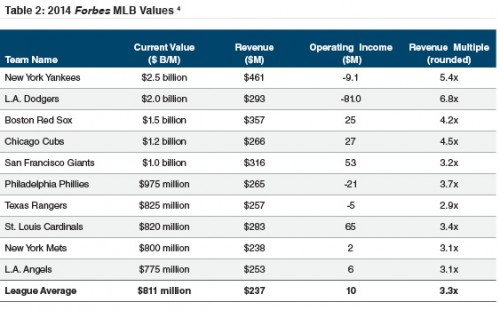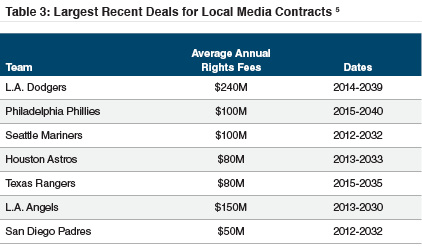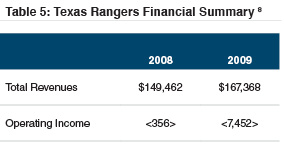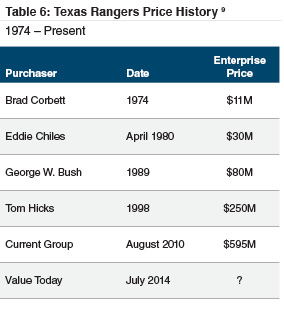Exploring the Major League Baseball Value Explosion
From 2000 to 2005, Major League Baseball teams were selling for much less than National Football League teams, i.e., typically under $200 million. Most of the MLB teams were showing losses at the time, and there was limited interest in buying the teams that did come up for sale. But the buying and selling environment changed dramatically in 2012, with the Los Angeles Dodgers selling for over $2.15 billion in a spirited auction with sixteen initial bidders.1
What has caused this explosion in MLB prices and do these high prices make sense?
In this article, I attempt to answer this question as I discuss MLB franchise price/value changes in the last fifteen years and whether these dramatic jumps in prices/values make economic/market sense.
First, I illustrate actual transaction prices for MLB teams in the early 2000s. I then show the significant increases—starting in 2008—leading to the blockbuster $2.15 billion Dodgers deal in 2012.
I then demonstrate the value changes published by Forbes Magazine and discuss key economic changes in the industry (i.e. MLB) that have contributed to these price jumps of twice—and sometimes three times—the 2005 prices for MLB franchises.
Finally, I explore the actual financials for the Texas Rangers and a history of the prices paid for the Rangers over the years.
For definition purposes, when we discuss values, we are always discussing enterprise (equity + debt), not equity values, and when we discuss revenue multiples, we are discussing total revenues from team/franchise and stadium interests, but excluding regional sports network (RSN) interests.
Deal Prices and MLB Values Estimated by Forbes Magazine
As Chart 1 shows, enterprise prices for MLB teams from 2000 to 2005 were less than $200 million, except for the 2004 Dodgers deal, which came in at $430 million. In 2006, two transactions increased to the low $400 million range. In 2008, a San Francisco Giants deal indicated $700 million, and the Chicago Cubs in 2009 were sold for over $800 million. In 2009 during the “Great Recession,” a smaller market team, the San Diego Padres, transacted at $500 million. Also in 2009, the Texas Rangers sold at $595 million during a bankruptcy bidding war. Finally, the chart shows the big jump with the bankruptcy auction prices of the L.A. Dodgers and their stadium and land at $2.15 billion in 2012.
Changes in Revenue Multiples
Unlike entities in other industries, major league sports teams are usually valued using a market approach rather than an income approach. Most of their enterprise values are referenced as a multiple of team and stadium revenues.
The multiples in revenues paid for actual transactions in the early 2000s were in the 2.0 times to 2.5 times range, but recent deals have been over 4.0 times revenues. The recent 4.0 times multiple reflects anticipated growth in revenues since sophisticated and well-heeled buyers are anticipating significant future revenue growth.
In Table 1, Forbes estimates are developed by Forbes editors utilizing public sources, their proprietary methods of estimating team revenues and expenses, and their judgment as to the valuation multiple to be applied to their revenue estimates.3
By 2014 (see Table 2), Forbes average MLB value estimate had jumped to $811 million and had a 3.3 times multiple. The values ranged from $2.5 billion for the Yankees to $485 million for the Tampa Bay Rays.
The average revenue estimates for the league have only increased from $183 million to $237 million or thirty percent. Yet the average valuation multiple increased from 2.6 times to 3.3 times causing the average team value to increase sixty-four percent. What caused this significant increase? The answer: potential for increased local revenues due to an explosion in media rights fees.
Meteoric Media Rights Fee Increases
As mentioned earlier, recent media rights fees for local broadcasts of MLB teams have increased three to five times that of older contracts. These older contracts may have been ten years in length, but the new ones can be in force as long as twenty-five years.
Unlike the total revenues for NFL teams and, to a lesser extent, those of the NBA, local media rights fees make up the majority of revenues for MLB teams. In many markets, the content providers (cable and satellite companies) are vying for a unique live product that can differentiate them in the marketplace. This competition has caused bidding wars for TV and other media rights to MLB teams.
The largest current local MLB media contract was negotiated by the L.A. Dodgers and was recently approved by MLB. In this contract, the L.A. Dodgers will reportedly receive $6 billion after a revenue-sharing split with MLB. This equates to an average of $240 million a year over twenty-five years. The old Dodgers contract was approximately $50 million dollars in its last year.
The next highest are the Texas Rangers and the Houston Astros at $80 million a year on average. In addition, the national TV MLB has jumped also—see Table 3.
It should be noted that part of the massive increase in payments to the L.A. Dodgers by Time Warner Cable is covered by Time Warner’s plan to pass the costs on to other pay TV providers, including Direct TV, Dish Network, Charter Communications, and Cox Communications.
Currently, Time Warner Cable and their providers are deadlocked on the price increases they will pay for airing the L.A. Dodger games. The providers contend that Time Warner’s cable price for their L.A. Dodger sports channel is too high. How this negotiation is settled will affect prices other providers pay nationwide. For example, the Houston Astros RSN has not been picked up by many of the local providers and the RSN has been forced to file for bankruptcy.
Table 4 shows the changes in the MLB National media contracts with the various networks. We note that the ESPN contracts increased from $296 million a year to $700 million a year. The Fox contract increased from $257 million a year to $525 million a year, etc. In short, the new national contracts increased by 120 percent from the other contract.
At the height of the recession, the San Diego Padres sold for $500 million in 2009. It resold in 2012 for $800 million due primarily to a major jump in a local media contract.
Are the teams making so much money that they warranted such a much higher price based on profits? The answer, surprisingly, is “no, not really.”
Case Study: Texas Rangers
The Texas Rangers sale in 2009 to the highest bidder out of bankruptcy court7 is a good example (Table 5).
Note that these numbers were prior to any regional media contract increases now scheduled to begin with the 2015 season.
Also note that annual amounts shown in the both the local and national contracts are averages and the initial year of the contract is usually much less than the average price shown.
All teams are subject to a player salary cap, which come with significant penalties if violated. So conceptually, if your revenues go up $50 million in a particular year, that amount could fall to the bottom line. How much is $50 million of profit worth to buyers whose primary value driver is not cash flow? It could be $500 million. It could be $1 billion. Which then causes people to wonder how much profit do these teams actually make?
The answer is that many lose money—some significant amounts. Many people ask why anyone would pay these amounts to buy teams if they do not make a reasonable profit.
There are two main answers to that:
- Every buyer has a different motivation.
- Few of us can look at “investments” through the lens of a multi-billionaire to whom a $10 to $50 million annual loss is not significant to their financial well-being.
Texas Rangers Price History
The Texas Rangers also provide a good example of transaction price changes in the MLB. Table 6 shows the transactions in the team since 1974.
Please note that in the $595 million 2010 transaction, the team was making very little money and with signing bonuses deducted, was not cash flow positive. What is the value of this team, considering such facts?
Conclusion
The intensity of local revenues for MLB has created a perfect storm for MLB teams as the media engages in a buying frenzy for live local sports entertainment.
Multiples of 4.0 times revenues are now becoming the new normal versus 2.0 times prior to 2006 driven by local revenue growth with media leading the way. Media contracts are increasing three to five times the annual amounts negotiated in the early to mid-2000s. The outlook for increased local media contracts will create new and higher MLB club transactions for years to come.
But what about value creation? In the case of the Dodgers, if their media revenue increases up hypothetically $200 million a year from the previous contract, how much increase in value will that create? Could it be an extra billion dollars or more? At the end of the day, these local media contract increases, coupled with the new increased national media contracts, generally tend to support the new much higher level of MLB prices.
Obviously, the smaller markets do not enjoy the same increases as the major markets like Los Angeles and New York, etc., but their new contracts will increase in multiples of older contracts i.e., from $15 to $20 million a year to $50 million plus as media providers compete for the exclusive content that live sports provides.
This article was originally published in The Value Examiner, September/October 2014.
Endnotes
- Brian Solomon, “$2 Billion Dodgers Sale Tops List of Most Expensive Sports Team Purchases Ever,” Forbes Magazine, March 29, 2012, http://www.forbes. com/sites/briansolomon/2012/03/29/2-billion-dodgers-sale-tops-list-ofmost-expensive-sports-team-purchases-ever/.
- Michael K. Ozanian and Kurt Badenhausen, “The Business of Baseball,” Forbes Magazine, April 16, 2008, http: http://www.forbes.com/2008/04/16/baseballteam-values-biz-sports-baseball08-cx_mo_kb_0416baseballintro.html. Note the remaining nineteen teams are shown on the NACVA website at http://www.nacva.com/examiner/14-SO-Charts.asp.
- Until recently, Forbes was the only public source of estimates for major league sports teams. They have been developing revenue, profit, and value estimates for over seventeen years. Numbers are as of Dec. 31, 2013.
- Mike Ozanian, “Baseball Team Values 2014 Led by New York Yankees at $2.5 Billion,” Forbes Magazine, March 26, 2014, http://www.forbes.com/sites/mikeozanian/2014/03/26/baseball-team-values-2014-led-by-newyork-yankees-at-2-5-billion/.
- Sources: Proprietary team sources.
- 6 Christina Settimi, “Baseball Scores 12 Billion in Baseball Deals,” Forbes Magazine, October 2, 2012, www.forbes.com.
- Bankruptcy Court For The Northern District Of Texas Fort Worth Division, Texas Rangers Baseball Partners, Chapter 11, Case No. 10-43400-DML.
- Source: Proprietary
- Source: Proprietary
